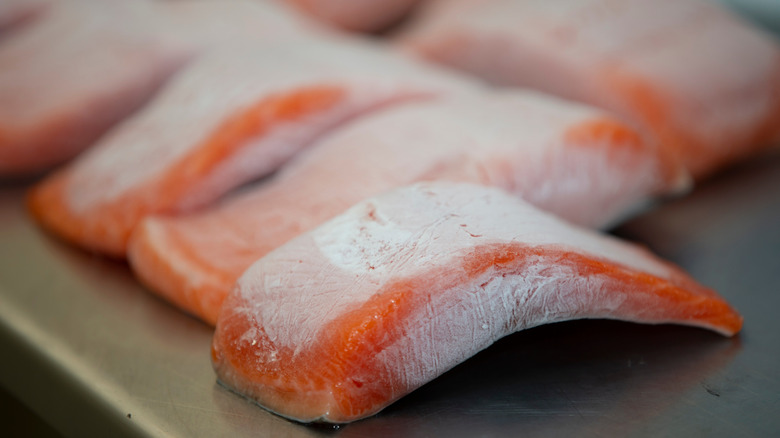Is It Possible To Pan Fry Salmon From Frozen?
We may receive a commission on purchases made from links.
Dinnertime. You wrap up your day and are looking forward to a warm, hearty salmon fillet with a garlic honey sauce and a nice side salad. But when you check the fridge, the salmon isn't there. Only then does it dawn on you that you never took it out of the freezer. What to do? Is it grilled cheese for dinner ... again? Even thawing the fish quickly in a bowl of cold water seems like it will take too long. Fortunately, it turns out, you can actually pan fry (or bake) frozen salmon. That's right, straight from the freezer.
According to the USDA, while the tastiest and best way to prepare frozen foods is to let them thaw for a day or two in the refrigerator (not on the counter), cooking foods from the frozen state is totally safe. It just requires some attention to detail. In general, you're going to cook frozen meats about 50% longer than if they were thawed, and you'll want to use a meat thermometer (the Meater Pro is a nice option) to ensure the internal temperature gets to 145 degrees Fahrenheit. In addition, there are some tricks to make certain your frozen salmon cooks to its flakiest best with a nice crisp skin.
Aim for flat and flash frozen when possible
At its core, cooking a frozen salmon fillet is that simple: If pan frying normally takes five to eight minutes, expect it to take about 10 to 12 from the frozen state. That said, there are ways to help ensure the fish comes out tender and flaky, instead of mushy. Frying fish frozen works best with thinner cuts. Those super thick cuts and salmon steaks are going to be best if thawed properly over a couple of days or (even better) cooked fresh.
The mantra "freeze flat," which works so well for organizing your freezer and guaranteeing a perfect brown crust on frozen steaks, works here too. Frozen salmon cooks less evenly than thawed or fresh salmon. If it ends up getting warped or mushy while freezing, that uneven cooking is magnified.
While it's totally fine to pan-fry any frozen fillet, the best ones for the task are those that have been flash frozen and vacuum sealed in advance. This is because it reduces the amount of ice crystal buildup, which can lead to spattering, uneven frying, and mushy flesh. In general, when cooking salmon straight from the freezer, you'll get better results with pre-packaged frozen fillets versus those from the butcher counter.
Tips for the best pan-fried salmon from frozen
The Alaska Seafood Marketing Institute has developed an entire, trademarked campaign dubbed "Cook It Frozen!" to help guide consumers in embracing the ease of frying, baking, or poaching frozen fish. In the case of stovetop cooking, since you want a great sear and crispy skin (and a cooked-through fillet), get your pan or grill hot (like 400 degrees Fahrenheit). Rinse the fish then pat it dry, or par-cook it for a few seconds on each side, to remove any ice crystals from the surface. Starting it flesh-side down first will help with the next step (seasoning).
Brush the fish with a high-heat oil like canola or olive oil before throwing it onto the pan. You'll want to hold off on doing any rubs, sauces, or spices up front. These won't be absorbed well into the frozen flesh and will likely burn with the longer cook time. Instead, wait until you've flipped the fish and season the cooked side first. Then, you can do a quick final sear of the spiced or sauced side if you want it a little charred.
This technique works with other frozen fish including cod and tuna. Once the fillet is dry and free of ice crystals, oiled up and ready to go, figure about three to four minutes on one side on high heat. Flip the fish over and reduce heat to medium (since the fish is now less frozen). Cook covered for five or six more minutes. Check the temperature and serve your perfectly cooked-from-frozen salmon.


